-
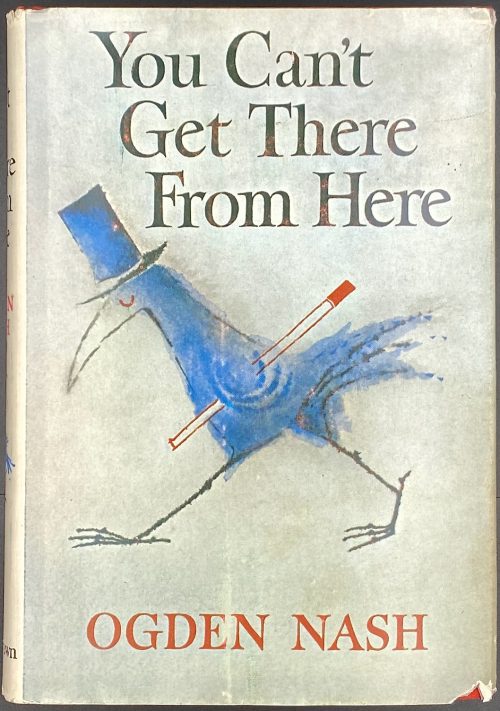 Description: In-8vo volume, 19.4 x 14 cm, bound in red cloth with gilt lettering to front cover and spine, in a pictorial dust jacket with a photo portrait of the author by Kay Bell to the rear, DJ and in-text illustrations by Maurice Sendak; pp. [i-x] xi-xvii [xviii] [2] 3-190, total 208 pages. Dust Jacket front: You Can't | Get There | From Here | {vignette} | OGDEN NASH || Title-page: OGDEN NASH | You Can't Get There | From Here | {vignettes} | DRAWINGS BY MAURICE SENDAK | Boston • LITTLE, BROWN AND COMPANY • Toronto || Edition: 1957, 8th printing; (1st edition in 1953) Contributors: Ogden Nash (American, 1902 – 1971) – author. Maurice Sendak (Jewish-American, 1928 – 2012) – artist. Kay Bell Reynal (American, 1905 – 1977) – photographer.
Description: In-8vo volume, 19.4 x 14 cm, bound in red cloth with gilt lettering to front cover and spine, in a pictorial dust jacket with a photo portrait of the author by Kay Bell to the rear, DJ and in-text illustrations by Maurice Sendak; pp. [i-x] xi-xvii [xviii] [2] 3-190, total 208 pages. Dust Jacket front: You Can't | Get There | From Here | {vignette} | OGDEN NASH || Title-page: OGDEN NASH | You Can't Get There | From Here | {vignettes} | DRAWINGS BY MAURICE SENDAK | Boston • LITTLE, BROWN AND COMPANY • Toronto || Edition: 1957, 8th printing; (1st edition in 1953) Contributors: Ogden Nash (American, 1902 – 1971) – author. Maurice Sendak (Jewish-American, 1928 – 2012) – artist. Kay Bell Reynal (American, 1905 – 1977) – photographer. -
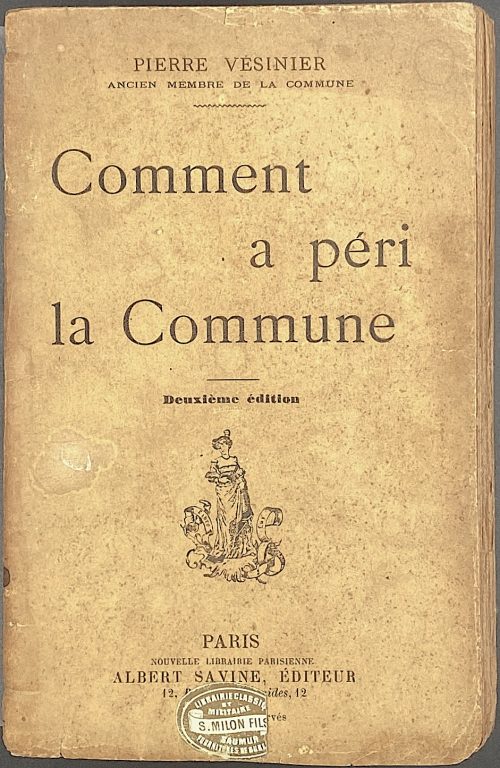 Softcover, 19 x 12 cm, publisher’s yellow wrappers with lettering to front, rear and spine, pp. [i-v] vi-xix [xx] [1] 2-474 [6], including index pp. 465-71 and contents pp.473-74. Bookseller’s label to front wrapper in the bottom: « LIBRAIRIE CLASSIQUE | ET | MILITAIRE | S. MILON FILS | SAUMUR | FOURNITURES DE BUREAU » Title-page: Pierre Vésinier | ANCIEN MEMBRE DE LA COMMUNE | — | COMMENT A PÉRI | LA COMMUNE | {publisher’s device} | PARIS | NOUVELLE LIBRAIRIE PARISIENNE | ALBERT SAVINE, ÉDITEUR | 12, RUE DES PYRAMIDES, 12 | – | Tous droits réservés. || Contributors: Pierre Vésinier (French, 1824 – 1902) – author. Albert Savine (French, 1859 – 1927) – publisher. Imprimerie de Saint-Denis, H. Bouillant (Paris) – printer.
Softcover, 19 x 12 cm, publisher’s yellow wrappers with lettering to front, rear and spine, pp. [i-v] vi-xix [xx] [1] 2-474 [6], including index pp. 465-71 and contents pp.473-74. Bookseller’s label to front wrapper in the bottom: « LIBRAIRIE CLASSIQUE | ET | MILITAIRE | S. MILON FILS | SAUMUR | FOURNITURES DE BUREAU » Title-page: Pierre Vésinier | ANCIEN MEMBRE DE LA COMMUNE | — | COMMENT A PÉRI | LA COMMUNE | {publisher’s device} | PARIS | NOUVELLE LIBRAIRIE PARISIENNE | ALBERT SAVINE, ÉDITEUR | 12, RUE DES PYRAMIDES, 12 | – | Tous droits réservés. || Contributors: Pierre Vésinier (French, 1824 – 1902) – author. Albert Savine (French, 1859 – 1927) – publisher. Imprimerie de Saint-Denis, H. Bouillant (Paris) – printer. -
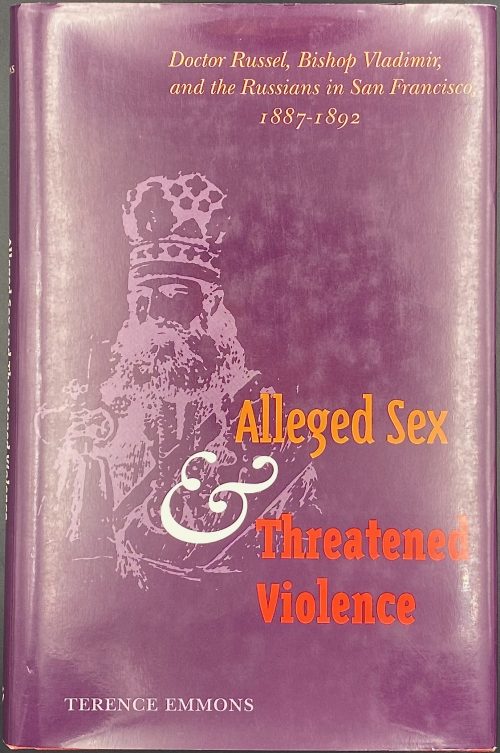 Hardcover volume, 22.5 x 15 cm, bound in red cloth with gilt lettering to spine, pictorial dust jacket; pp.: [i-v] vi-xiv, [1-5] 6-251 [252], total 268 pages. Title-page: Alleged sex and threatened violence | Doctor Russel, Bishop Vladimir, and the Russians in | San Francisco, 1887-1892 | TERENCE EMMONS | — | Stanford University Press | Stanford, California | 1977 || ISBN: 9780804727679, 9780804727686, 0804727678, 0804727686. OCLC Number / Unique Identifier: 35159156. Doctor Nikolai Sudzilovsky [Nicholas Russel] (Belarusian, 1850 – 1930). Bishop Vladimir (Sokolovsky-Avtonomov, Vasily Grigorievich) Архиепископ Владимир (Соколовский-Автономов, Василий Григорьевич) (Russian, 1852 – 1931) – Archbishop of the Aleutians and Alaska.
Hardcover volume, 22.5 x 15 cm, bound in red cloth with gilt lettering to spine, pictorial dust jacket; pp.: [i-v] vi-xiv, [1-5] 6-251 [252], total 268 pages. Title-page: Alleged sex and threatened violence | Doctor Russel, Bishop Vladimir, and the Russians in | San Francisco, 1887-1892 | TERENCE EMMONS | — | Stanford University Press | Stanford, California | 1977 || ISBN: 9780804727679, 9780804727686, 0804727678, 0804727686. OCLC Number / Unique Identifier: 35159156. Doctor Nikolai Sudzilovsky [Nicholas Russel] (Belarusian, 1850 – 1930). Bishop Vladimir (Sokolovsky-Avtonomov, Vasily Grigorievich) Архиепископ Владимир (Соколовский-Автономов, Василий Григорьевич) (Russian, 1852 – 1931) – Archbishop of the Aleutians and Alaska. -
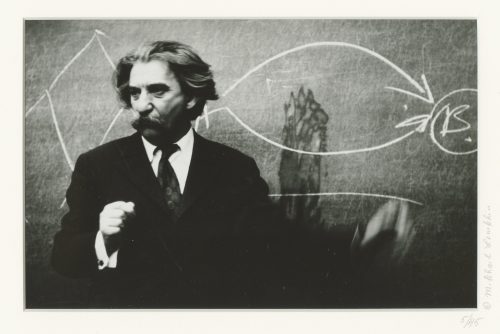 Photographic half-length portrait of academician Juri Lotman, with his head turned to the left, giving a lecture in front of a blackboard. Pencil-signed on the mat: 5/45 • ©Mikhail Lemkhin; on the back of the print: ink stamp ©MIKHAIL LEMKHIN, pencil inscription Mikhail Lemkhin 5/45; ink stamp: PHOTO BY MIKHAIL LEMKHIN | 1811–38th AVENUE | SAN FRANCISCO, CA 94122 | (415) 664-7677; Copyright statement ink stamp; on the back of the mat: pencil inscription (top) ЛОТМАН, ЮРИЙ | YURI LOTMAN, (bottom) VI. Size: mat: 35.6 x 43.1 cm; window: 15.5 x 24 cm; print: 20.2 x 25.3 cm. Limited edition of 45, of which this is № 5, signed and stamped by the artist. Sitter: Juri Lotman [Юрий Михайлович Лотман] (Estonian-Jewish, 1922 – 1993).
Photographic half-length portrait of academician Juri Lotman, with his head turned to the left, giving a lecture in front of a blackboard. Pencil-signed on the mat: 5/45 • ©Mikhail Lemkhin; on the back of the print: ink stamp ©MIKHAIL LEMKHIN, pencil inscription Mikhail Lemkhin 5/45; ink stamp: PHOTO BY MIKHAIL LEMKHIN | 1811–38th AVENUE | SAN FRANCISCO, CA 94122 | (415) 664-7677; Copyright statement ink stamp; on the back of the mat: pencil inscription (top) ЛОТМАН, ЮРИЙ | YURI LOTMAN, (bottom) VI. Size: mat: 35.6 x 43.1 cm; window: 15.5 x 24 cm; print: 20.2 x 25.3 cm. Limited edition of 45, of which this is № 5, signed and stamped by the artist. Sitter: Juri Lotman [Юрий Михайлович Лотман] (Estonian-Jewish, 1922 – 1993). -
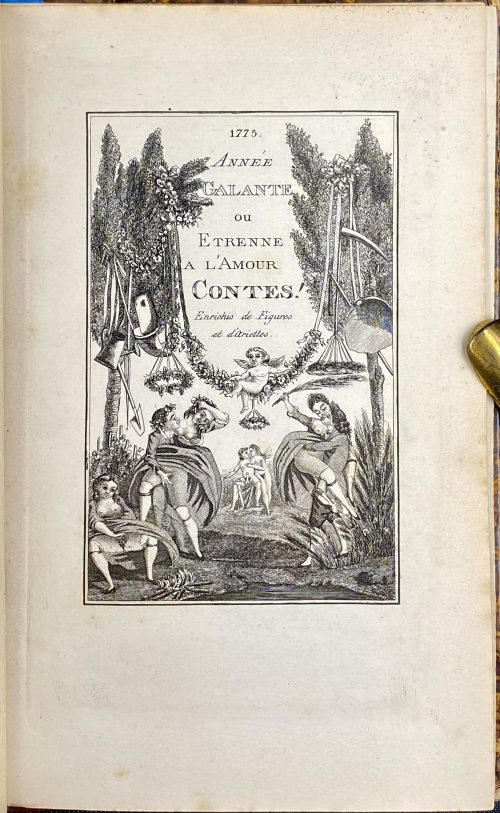 Single volume, 20 x 13 cm, quarter brown morocco over marbled boards tooled in gilt, spine with raised bands, gilt in compartments, and gilt lettering, marbled endpapers, printed on wove paper on recto with verso blank, collated 1-48; total 32 leaves, 11 torn off, 47,8 blanks, ; uneven pagination [1] 2-41 [4 blanks], plus engraved title-page and 12 engraved half-page plates with text, uncoloured, by Louis Jaugey (unsigned), one for each month. Title-page (engraved): vignette with lettering "1775. ANNÉE | GALANTE | OU | ETRENNE | A L'AMOUR | CONTES! | Enrichis de Figures | et d'Ariettes. ||" Catalogue raisonné: Dutel I: A-82. Catalogue Poulet-Malassis & ses amis description: № 68. [Auteur inconnu]. Année galante ou Etrenne à l’amour. Contes, enrichis de Figures et d’Ariees. [Vital Puissant, Bruxelles, 1876 ?] 1775. In-8, 3 .n.ch., 29 . imprimés au recto, chirés de 2 à 41, demi-chagrin brun, dos à nerfs orné, let doré sur les mors, tête et tranches jaspées (reliure ancienne). Illustrée de 13 planches dont l’une en frontispice par Louis Jaugey. Les figures sont à mi-page, une pour chaque mois. Contributors: Louis Jaugey (French, fl. 1871 – 1876) – artist. Vital Puissant (Belgian, 1835 – 1878) – publisher.
Single volume, 20 x 13 cm, quarter brown morocco over marbled boards tooled in gilt, spine with raised bands, gilt in compartments, and gilt lettering, marbled endpapers, printed on wove paper on recto with verso blank, collated 1-48; total 32 leaves, 11 torn off, 47,8 blanks, ; uneven pagination [1] 2-41 [4 blanks], plus engraved title-page and 12 engraved half-page plates with text, uncoloured, by Louis Jaugey (unsigned), one for each month. Title-page (engraved): vignette with lettering "1775. ANNÉE | GALANTE | OU | ETRENNE | A L'AMOUR | CONTES! | Enrichis de Figures | et d'Ariettes. ||" Catalogue raisonné: Dutel I: A-82. Catalogue Poulet-Malassis & ses amis description: № 68. [Auteur inconnu]. Année galante ou Etrenne à l’amour. Contes, enrichis de Figures et d’Ariees. [Vital Puissant, Bruxelles, 1876 ?] 1775. In-8, 3 .n.ch., 29 . imprimés au recto, chirés de 2 à 41, demi-chagrin brun, dos à nerfs orné, let doré sur les mors, tête et tranches jaspées (reliure ancienne). Illustrée de 13 planches dont l’une en frontispice par Louis Jaugey. Les figures sont à mi-page, une pour chaque mois. Contributors: Louis Jaugey (French, fl. 1871 – 1876) – artist. Vital Puissant (Belgian, 1835 – 1878) – publisher. -
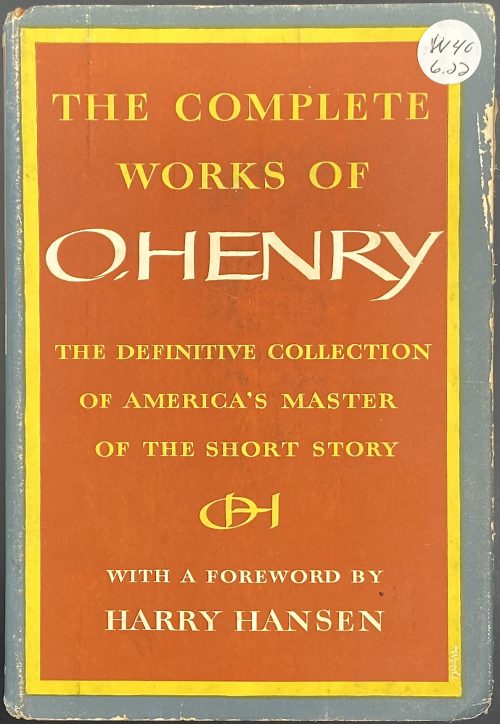 Two hardcover volumes, 22 x 15 cm each, uniformly bound in quarter orange cloth over blue cloth, red and blue lettering to spine, in a dust jacket lettered in yellow and white over red THE COMPLETE | WORKS OF | O. HENRY | THE DEFINITIVE COLLECTION | OF AMERICA’S MASTER | OF THE SHORT STORY | { OH monogram} | WITH A FOREWORD BY | HARRY HANSEN || Title-page: THE COMPLETE WORKS OF O. HENRY | FOREWORD BY HARRY HANSEN | VOLUME I (II) | 1953 | DOUBLEDAY & COMPANY, INC. GARDEN CITY, NY || Vol. 1: ffl, [i-v] vi-xiii [xiv] [2] [1] 2-810, ffl. Vol. 2: ffl, [i-v] vi-viii [2] [811] 812-1692, ffl. Contributors: O. Henry [William Sydney Porter] (American, 1862 – 1910) – author. Harry Hansen (American, 1884 – 1977) – author/foreword.
Two hardcover volumes, 22 x 15 cm each, uniformly bound in quarter orange cloth over blue cloth, red and blue lettering to spine, in a dust jacket lettered in yellow and white over red THE COMPLETE | WORKS OF | O. HENRY | THE DEFINITIVE COLLECTION | OF AMERICA’S MASTER | OF THE SHORT STORY | { OH monogram} | WITH A FOREWORD BY | HARRY HANSEN || Title-page: THE COMPLETE WORKS OF O. HENRY | FOREWORD BY HARRY HANSEN | VOLUME I (II) | 1953 | DOUBLEDAY & COMPANY, INC. GARDEN CITY, NY || Vol. 1: ffl, [i-v] vi-xiii [xiv] [2] [1] 2-810, ffl. Vol. 2: ffl, [i-v] vi-viii [2] [811] 812-1692, ffl. Contributors: O. Henry [William Sydney Porter] (American, 1862 – 1910) – author. Harry Hansen (American, 1884 – 1977) – author/foreword. -
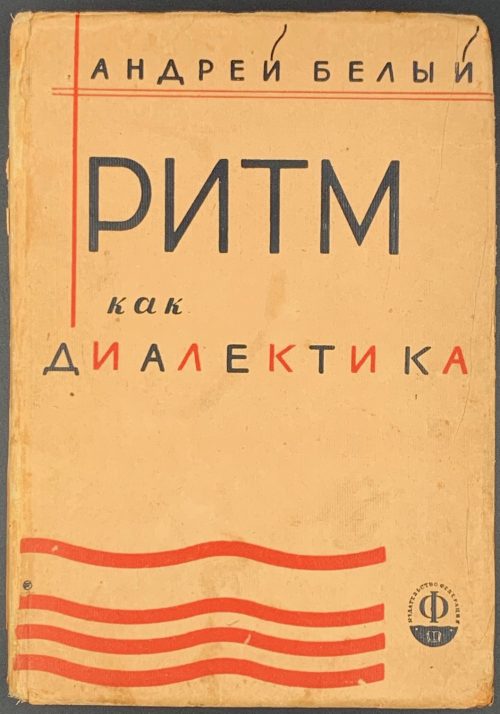 Hardcover, 19.8 x 14 cm, tan paper over cardboard with black and red lettering and design elements to front, black lettering to back and spine, pp.: fep, [1-8] (publ. device/blank, t.p./imprint, foreword, f.t./blank), [9] intro, 10-279 [280] contents, fep; blue crayon to fep recto Ф. Аншуков, ink mark to t.p. К. Collated 8vo: 1-178, 184, total 140 leaves. Title-page: АНДРЕЙ БЕЛЫЙ | РИТМ | КАК ДИАЛЕКТИКА | И | «МЕДНЫЙ ВСАДНИК» | ИССЛЕДОВАНИЕ | ИЗДАТЕЛЬСТВО | «ФЕДЕРАЦИЯ» | МОСКВА – 1929 || Contributors: Андрей Белый [Andrei Bely, Борис Николаевич Бугаев] (Russian, 1880 – 1934) – author.
Hardcover, 19.8 x 14 cm, tan paper over cardboard with black and red lettering and design elements to front, black lettering to back and spine, pp.: fep, [1-8] (publ. device/blank, t.p./imprint, foreword, f.t./blank), [9] intro, 10-279 [280] contents, fep; blue crayon to fep recto Ф. Аншуков, ink mark to t.p. К. Collated 8vo: 1-178, 184, total 140 leaves. Title-page: АНДРЕЙ БЕЛЫЙ | РИТМ | КАК ДИАЛЕКТИКА | И | «МЕДНЫЙ ВСАДНИК» | ИССЛЕДОВАНИЕ | ИЗДАТЕЛЬСТВО | «ФЕДЕРАЦИЯ» | МОСКВА – 1929 || Contributors: Андрей Белый [Andrei Bely, Борис Николаевич Бугаев] (Russian, 1880 – 1934) – author. -
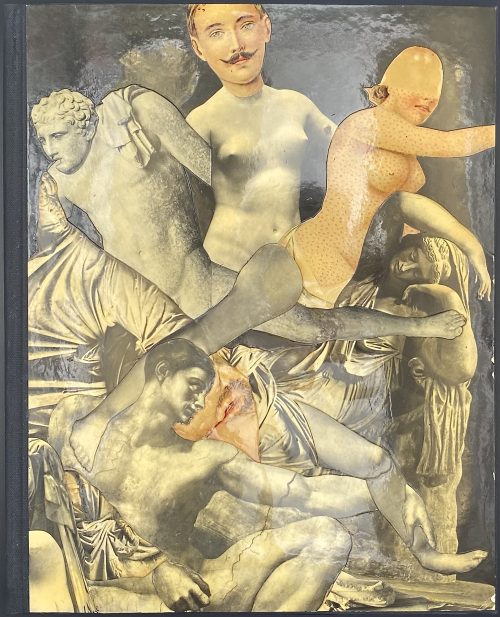 Hardcover volume, 25.2 x 20.5 cm, in a double slipcase 26.3 x 21.5 cm; black boards on cloth spine, front board with pasted photocollage in colour, first leaf thick verge paper different to the rest of the edition; top margin red, text printed on cream laid paper without a watermark and adorned with 14 in-text lithographs in black. A suite of 20 coloured lithographs 245 x 195 mm in the inner slipcase. Plates by Berthomme Saint-André. Pagination: [2] blanks, [3-8] 9-100 [101] blank, [2] colophon, limit. [2] blanks. Title-page (red and black): A. DE M. | GAMIANI | ou | deux nuits d'excès | Édition Réalisée | par les soins | et au profit exclusif des | « Vrais Amateurs Romantiques » | (Groupement de bibliophiles) || Limitation: № 1 – on Tonkin à la forme paper with two sets of plates, on Tonkin and one on Arches, printed in colour and in black, etc.; № 2 – similar but with the earlier state of one suite of plates; №№ 3-52 on Arches verge with plates on Tonkin; №№ 53-127 on Arches verge with plates on the same; №№ 128-227 on Rives with the suites on paper watermarked “Japon”; №№ 228-672 on Rives with the suites on the same; 25 copies marked A-Z of which A-J on Arches vergé and suites on Tonkin, and K-Z on Rives. Altogether 697 copies, of which this is copy № 27. Catalogue raisonné: Dutel III № 1650, p. 187-8; honesterotica.com. with a partially different set of in-text illustrations. Alfred de Musset (French, 1810 – 1857) – author. Louis Berthomme Saint-André (French, 1905 – 1977) – artist.
Hardcover volume, 25.2 x 20.5 cm, in a double slipcase 26.3 x 21.5 cm; black boards on cloth spine, front board with pasted photocollage in colour, first leaf thick verge paper different to the rest of the edition; top margin red, text printed on cream laid paper without a watermark and adorned with 14 in-text lithographs in black. A suite of 20 coloured lithographs 245 x 195 mm in the inner slipcase. Plates by Berthomme Saint-André. Pagination: [2] blanks, [3-8] 9-100 [101] blank, [2] colophon, limit. [2] blanks. Title-page (red and black): A. DE M. | GAMIANI | ou | deux nuits d'excès | Édition Réalisée | par les soins | et au profit exclusif des | « Vrais Amateurs Romantiques » | (Groupement de bibliophiles) || Limitation: № 1 – on Tonkin à la forme paper with two sets of plates, on Tonkin and one on Arches, printed in colour and in black, etc.; № 2 – similar but with the earlier state of one suite of plates; №№ 3-52 on Arches verge with plates on Tonkin; №№ 53-127 on Arches verge with plates on the same; №№ 128-227 on Rives with the suites on paper watermarked “Japon”; №№ 228-672 on Rives with the suites on the same; 25 copies marked A-Z of which A-J on Arches vergé and suites on Tonkin, and K-Z on Rives. Altogether 697 copies, of which this is copy № 27. Catalogue raisonné: Dutel III № 1650, p. 187-8; honesterotica.com. with a partially different set of in-text illustrations. Alfred de Musset (French, 1810 – 1857) – author. Louis Berthomme Saint-André (French, 1905 – 1977) – artist. -
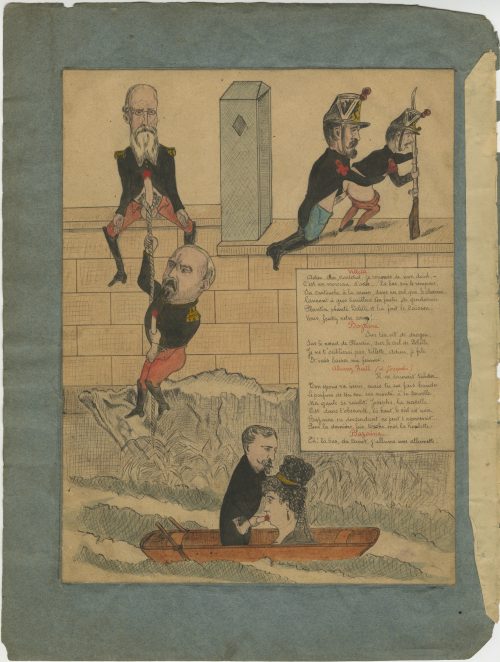 A series of seven political caricatures with indecent content, ink and pigment on paper, bound in a grey-blue folder. Each drawing is pasted to a grey-blue sheet of paper 32 x 24 cm. PLATES: 1) Villette; Bazaine; Alvarez Rull: 250 x 192 mm
A series of seven political caricatures with indecent content, ink and pigment on paper, bound in a grey-blue folder. Each drawing is pasted to a grey-blue sheet of paper 32 x 24 cm. PLATES: 1) Villette; Bazaine; Alvarez Rull: 250 x 192 mm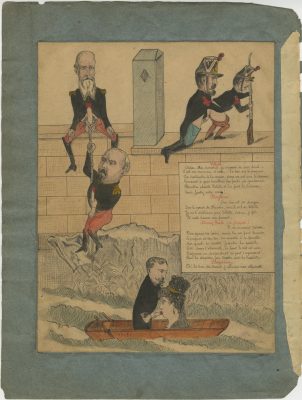
Villette Adieu, cher maréchal, je réponds de mon dard C’est un morceau d’acier… Là bas, sur le rempart, Sa cartouche à la main, dans un cul qui le charme, Lançant à gros bouillons son foutre de gendarme Plantin plante Delille et lui font le Caisson. Bazaine Sur ton vit de dragon Sur le nœud de Plantin, sur le cul de Delille, Je ne t’oublierai pas, Villette, adieu, je file Et je vais baiser ma femme. Alvarez Rull (à Josépha) Il ne saurait tarder, Ton epoux va venir, mais tu me fais bander, Le parfum de ton con me monte à la cervelle, Ma gaule se raidit . Josépha, la nacelle Est dans l’ obscurité, là haut, le ciel est noir, Bazaine en descendant ne peut t’ apercevoir … Pour la dernière fois, torche moi la houlette. Bazaine Eh ! là bas, du canot, j’allume une allumette!
Villette Farewell, dear Marshal, I vouch for my dick. It’s like a steel rod … Over there, on the ramparts, Plantin, his dick in hand, pounds Delisle’s beckoning ass And fills it with his bubbling gendarme’s cum. Bazaine For your dragoon’s dick, For Plantin's prick, for Delisle's ass, I won't forget you, Villette, goodbye, I'm leaving And I'm going to fuck my wife. Alvarez Rull (to Josépha) Hurry up, Your husband is coming, but I got a hard on you, The scent of your cunt penetrates my brain, My rod stiffened. Josépha, the gondola Is in the dark, the sky is black, Bazaine coming down and cannot see you... Give me one last blowjob.Bazaine Hey! Over there, from the canoe, I light a match!
French marshal Achille Bazaine capitulated to Bismarck during the Franco-Prussian war on 27 October 1870. In 1873, he was tried for treason and received a death sentence, later commuted to 20 years' imprisonment. Bazaine was incarcerated in the Fort Royal on Île Sainte-Marguerite, from which he escaped on August 9–10, 1874, with the help of Colonel Villette [Willette], his wife Josefa [Pepita Peña], and her nephew Alvarez Rull. They sailed to Genoa in Italy and from there to London. Plantin and Delisle were prison guards. The story was described in detail during the Trial of Col. Villette and his Accomplices in 1874 and published later in Robert Christophe. La Vie tragique du maréchal Bazaine. — Paris: Vautrain Jacques, 1947.
2) Impératrice Eugénie: 218 x 165 mm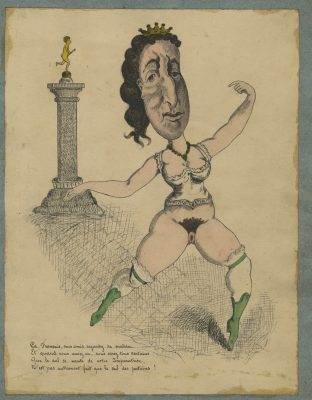
Ça, Français, mes amis, regardez sa matrice, Et quand vous aurez vu, vous serez tous certains Que le cul si vanté de votre Impératrice, N’est pas autrement fait que le cul des putains!
That, French, my friends, look at her cunt, And when you have seen, you will all be certain That the so acclaimed ass of your Empress, Is no different than the ass of whores! 3) Napoléon III: 215 x 168 mm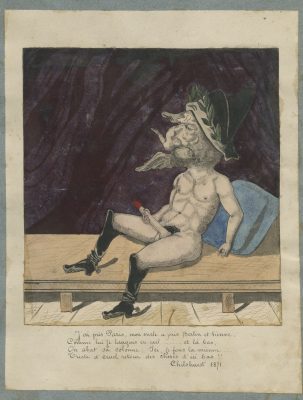
J’ai pris Paris, mon oncle a pris Berlin et Vienne. Comme lui je languis en exil …… et là bas, On abat sa colonne; Ici, je fous la mienne…. Triste et cruel retour des choses d’ici bas!! Chilshurst 1871. [i.e. Chislehurst]
I took Paris, my uncle took Berlin and Vienna. Like him, I, too, languish in exile. His column there was demolished; I’m jerking mine off here…. Cruel and sorrowful deeds!! 4) La confession: 216 x 168 mm (Georges Darboy?)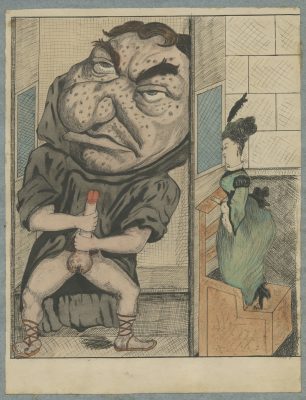 5) Napoléon III et Thérèsa (chanteuse Désirée Emma Valladon): 216 x 176 mm
5) Napoléon III et Thérèsa (chanteuse Désirée Emma Valladon): 216 x 176 mm
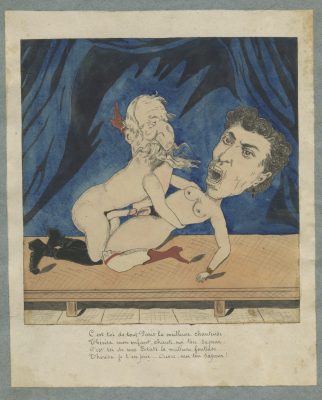
C’est toi de tout Paris la meilleure chanteuse, Thérèsa mon enfant, chante-moi ton sapeur. C’est toi de mes Etats la meilleure fonteuse.. Thérèsa je t’en prie … Ouvre-moi ton sapeur!
You, the best singer in all of Paris, Teresa, my child, sing for me where to insert. You are the best padding in my entire country… Teresa, please... Open your slit for me! 6) Thiers: 219 x 168 mm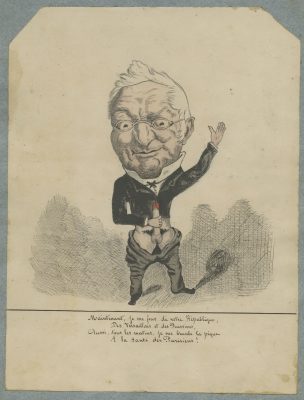
Maintenant, je me fous de votre République, Des Versaillais et des Prussiens, Aussi, tous les matins, je me branle la pique A la santé des Parisiens!
Yes, I don’t care about your Republic now, About Versailles and the Prussians, And every morning I jerk off For the health of Parisians! 7) Émile Ollivier/Rochefort/Jules Favre/Gambetta : 212 x 168 mm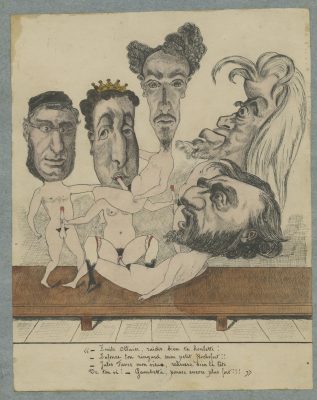
« — Emile Ollivier, raidis bien la houlette! — Enfonce ton ringard mon petit Rochefort!! — Jules Favre mon vieux, redresse bien la tête De ton vi! — Gambetta, pousse encore plus fort!!! »
Emile Ollivier, tighten your dick! - Stick in your poker, my little Rochefort!! - Jules Favre, old man, straighten your dickhead Damn it! – Gambetta, push even harder!!!Characters: Bazaine, François Achille (French, 1811 – 1888) Darboy, Georges (French, 1813 – 1871) Favre, Jules (French, 1809 – 1880) Gambetta, Léon (French, 1838 – 1882) Montijo, Eugénie de (Spanish-French, 1826 – 1920) Napoleon III [Bonaparte, Charles-Louis Napoléon] (French, 1808 – 1873) Ollivier, Émile (French, 1825 – 1913) Peña Azcárate, Josefa [Peña, Pepita] (Mexican-French, 1847 – 1900); Alvarez Rull – nephew of Josefa Peña Azcárate. Rochefort, Henri (French, 1831 – 1913) Thérésa [Valladon, Désirée Emma] (French, 1836 – 1913) Thiers, Adolphe (French, 1797 – 1877)
-
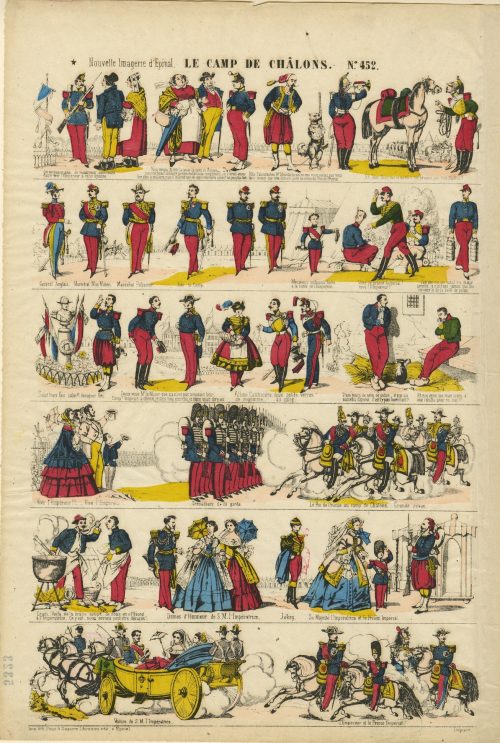 Hand-coloured woodcut on wove paper, 409 x 280 mm; black ink stamp “5323” to reverse; attached to the sheet 487 x 320 mm. Top centre: "LE CAMP DE CHALONS."; left: "Nouvelle Imagerre d'Epinal"; right: № 452. Bottom left: "Imp lith. Pinot & Sagaire, libraires edit. à Épinal"; right: "Déposé". Image: 6-tier cartoon with captions about Napoleon III and his son Prince Imperial (Napoléon Eugène Louis Jean Joseph Bonaparte; 16 March 1856 – 1 June 1879). Le camp de Chalons Pinot & Sagaire (Épinal, 1861 – 1888) – enterprise, publisher/printer. Charles-François Pinot (French, 1817 – 1879) – publisher/printer.
Hand-coloured woodcut on wove paper, 409 x 280 mm; black ink stamp “5323” to reverse; attached to the sheet 487 x 320 mm. Top centre: "LE CAMP DE CHALONS."; left: "Nouvelle Imagerre d'Epinal"; right: № 452. Bottom left: "Imp lith. Pinot & Sagaire, libraires edit. à Épinal"; right: "Déposé". Image: 6-tier cartoon with captions about Napoleon III and his son Prince Imperial (Napoléon Eugène Louis Jean Joseph Bonaparte; 16 March 1856 – 1 June 1879). Le camp de Chalons Pinot & Sagaire (Épinal, 1861 – 1888) – enterprise, publisher/printer. Charles-François Pinot (French, 1817 – 1879) – publisher/printer. -
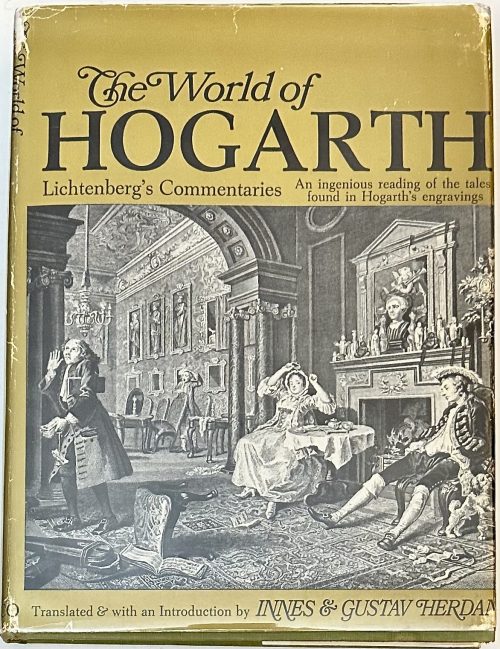 Hardcover volume, 25.3 x 19.3 cm, green cloth with gilt lettering to front and spine, pictorial dust jacket, pp.: [1 blank] [i-viii] ix-xxiii [xxiv blank] [2] 3-297 [298 blank] [8 blanks], 26 plates, unpaginated. MS inscription in black ink to ffl “David Tatham 1969”. Title-page: The World of | HOGARTH | Lichtenberg's Commentaries | on Hogarth's Engravings | TRANSLATED FROM THE GERMAN | AND WITH AN INTRODUCTION BY | INNES AND GUSTAV HERDAN | HOUGHTON MIFFLIN COMPANY BOSTON | The Riverside Press Cambridge | 1966 || Illustrations: A Harlot's Progress; Marriage-à-la-Mode; Strolling Actresses Dressing in a Barn; A Midnight Modern Conversation or The Bacchanalians; A Rake's Progress; The Four Times of the Day: Morning, Noon, Evening, Night. Edition: First printing w; Printed in the United States of America. Provenance (possibly): David Tatham (American, 1932 – 2023) Contributors: George Christoph Lichtenberg (German, 1743 – 1799) Innes Herdan (British, 1911 – ?) Gustav Herdan (German, 1897 – 1968) William Hogarth (British, 1697 – 1764)
Hardcover volume, 25.3 x 19.3 cm, green cloth with gilt lettering to front and spine, pictorial dust jacket, pp.: [1 blank] [i-viii] ix-xxiii [xxiv blank] [2] 3-297 [298 blank] [8 blanks], 26 plates, unpaginated. MS inscription in black ink to ffl “David Tatham 1969”. Title-page: The World of | HOGARTH | Lichtenberg's Commentaries | on Hogarth's Engravings | TRANSLATED FROM THE GERMAN | AND WITH AN INTRODUCTION BY | INNES AND GUSTAV HERDAN | HOUGHTON MIFFLIN COMPANY BOSTON | The Riverside Press Cambridge | 1966 || Illustrations: A Harlot's Progress; Marriage-à-la-Mode; Strolling Actresses Dressing in a Barn; A Midnight Modern Conversation or The Bacchanalians; A Rake's Progress; The Four Times of the Day: Morning, Noon, Evening, Night. Edition: First printing w; Printed in the United States of America. Provenance (possibly): David Tatham (American, 1932 – 2023) Contributors: George Christoph Lichtenberg (German, 1743 – 1799) Innes Herdan (British, 1911 – ?) Gustav Herdan (German, 1897 – 1968) William Hogarth (British, 1697 – 1764) -
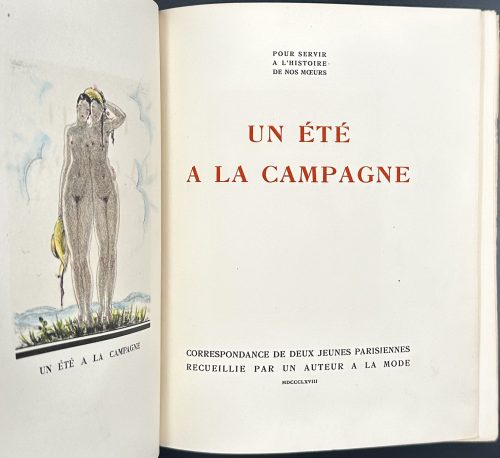 Softcover, 228 x 180 mm, tan French flapped wrappers with red lettering to front[1-4, owner’s glassine dustcover, top edge trimmed, printed on thick wove paper without a watermark; pp.: ffl [1-4 h.t., t.p.] 5-154 [2 blanks] colophon to back ffl recto, plus 12 plates with hand-coloured lithographs, extraneous to collation. Pencil and pigment drawing to h.t. signed “J. D’A” with gift manual inscription “A Monsieur et Madame Chalamel [sic] ce tardif mais sincère souvenir de sympathie”, signed “J et Y D’A.” Etching bookplate to front ffl recto: “EX LIBRIS PIERRE CHALLAMEL | JE FONCE DANS LE BROUILLARD”, signed “J A M” (Jean-Adrien Mercier). The signature J. D’A stands for Jean d’Angers, while Y D’A stands for Jean-Adrien’s wife Yvonne (1902—1999), nicknamed Zizi; they married in 1927. According to J.-P. Dutel, the stated illustrator of this edition, Jean d’Angers is indeed Jean-Adrien Mercier. The text belongs to Gustav Droz and, possibly, Auguste Poulet-Malassis. Limitation: the book was printed for subscribers in 30 copies on Japon Impériale paper (№№ 1-30) and 250 copies on vélin du Marais paper (№№ 31-280). This copy bears № 123 and was presented as a gift by the artist and his wife to Pierre Challamel. Title-page (red and black): POUR SERVIR | A L'HISTOIRE | DE NOS MŒURS | UN ÉTÉ | A LA CAMPAGNE | CORRESPONDANCE DE DEUX JEUNES PARISIENNES | RECUEILLIE PAR UN AUTEUR A LA MODE | MDCCCLXVIII || Catalogue raisonné: Dutel III № 2546; honesterotica. Provenance: Pierre Challamel (French, 20th century) Contributors: Gustave Droz (French, 1832 – 1895) – author (presumable). Auguste Poulet-Malassis (French, 1825 – 1878) – author (presumable). Jean-Adrien Mercier (French, 1899 – 1995) – artist. Micro photo of the lithography:
Softcover, 228 x 180 mm, tan French flapped wrappers with red lettering to front[1-4, owner’s glassine dustcover, top edge trimmed, printed on thick wove paper without a watermark; pp.: ffl [1-4 h.t., t.p.] 5-154 [2 blanks] colophon to back ffl recto, plus 12 plates with hand-coloured lithographs, extraneous to collation. Pencil and pigment drawing to h.t. signed “J. D’A” with gift manual inscription “A Monsieur et Madame Chalamel [sic] ce tardif mais sincère souvenir de sympathie”, signed “J et Y D’A.” Etching bookplate to front ffl recto: “EX LIBRIS PIERRE CHALLAMEL | JE FONCE DANS LE BROUILLARD”, signed “J A M” (Jean-Adrien Mercier). The signature J. D’A stands for Jean d’Angers, while Y D’A stands for Jean-Adrien’s wife Yvonne (1902—1999), nicknamed Zizi; they married in 1927. According to J.-P. Dutel, the stated illustrator of this edition, Jean d’Angers is indeed Jean-Adrien Mercier. The text belongs to Gustav Droz and, possibly, Auguste Poulet-Malassis. Limitation: the book was printed for subscribers in 30 copies on Japon Impériale paper (№№ 1-30) and 250 copies on vélin du Marais paper (№№ 31-280). This copy bears № 123 and was presented as a gift by the artist and his wife to Pierre Challamel. Title-page (red and black): POUR SERVIR | A L'HISTOIRE | DE NOS MŒURS | UN ÉTÉ | A LA CAMPAGNE | CORRESPONDANCE DE DEUX JEUNES PARISIENNES | RECUEILLIE PAR UN AUTEUR A LA MODE | MDCCCLXVIII || Catalogue raisonné: Dutel III № 2546; honesterotica. Provenance: Pierre Challamel (French, 20th century) Contributors: Gustave Droz (French, 1832 – 1895) – author (presumable). Auguste Poulet-Malassis (French, 1825 – 1878) – author (presumable). Jean-Adrien Mercier (French, 1899 – 1995) – artist. Micro photo of the lithography:
Micro photo of the original drawing: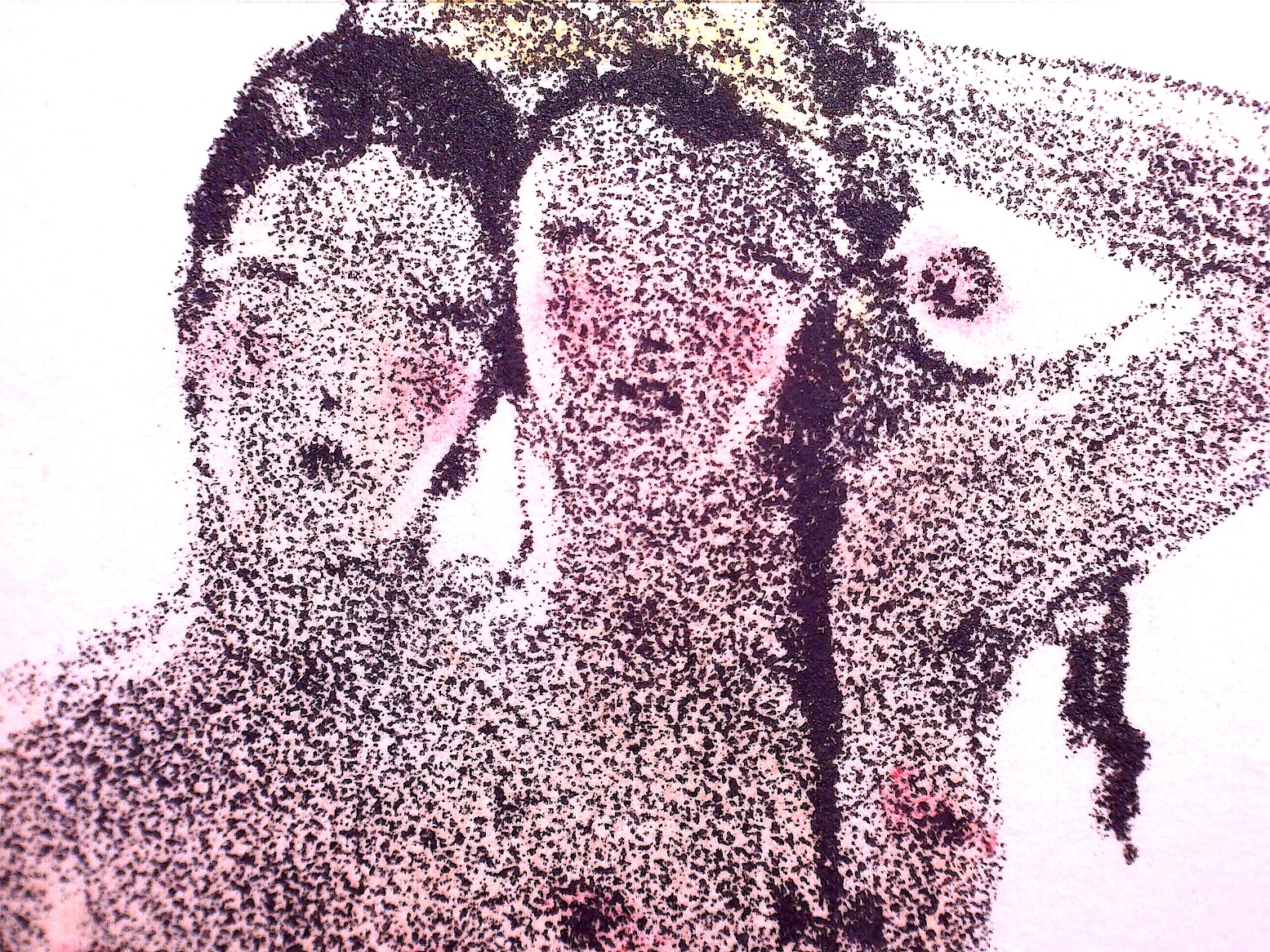
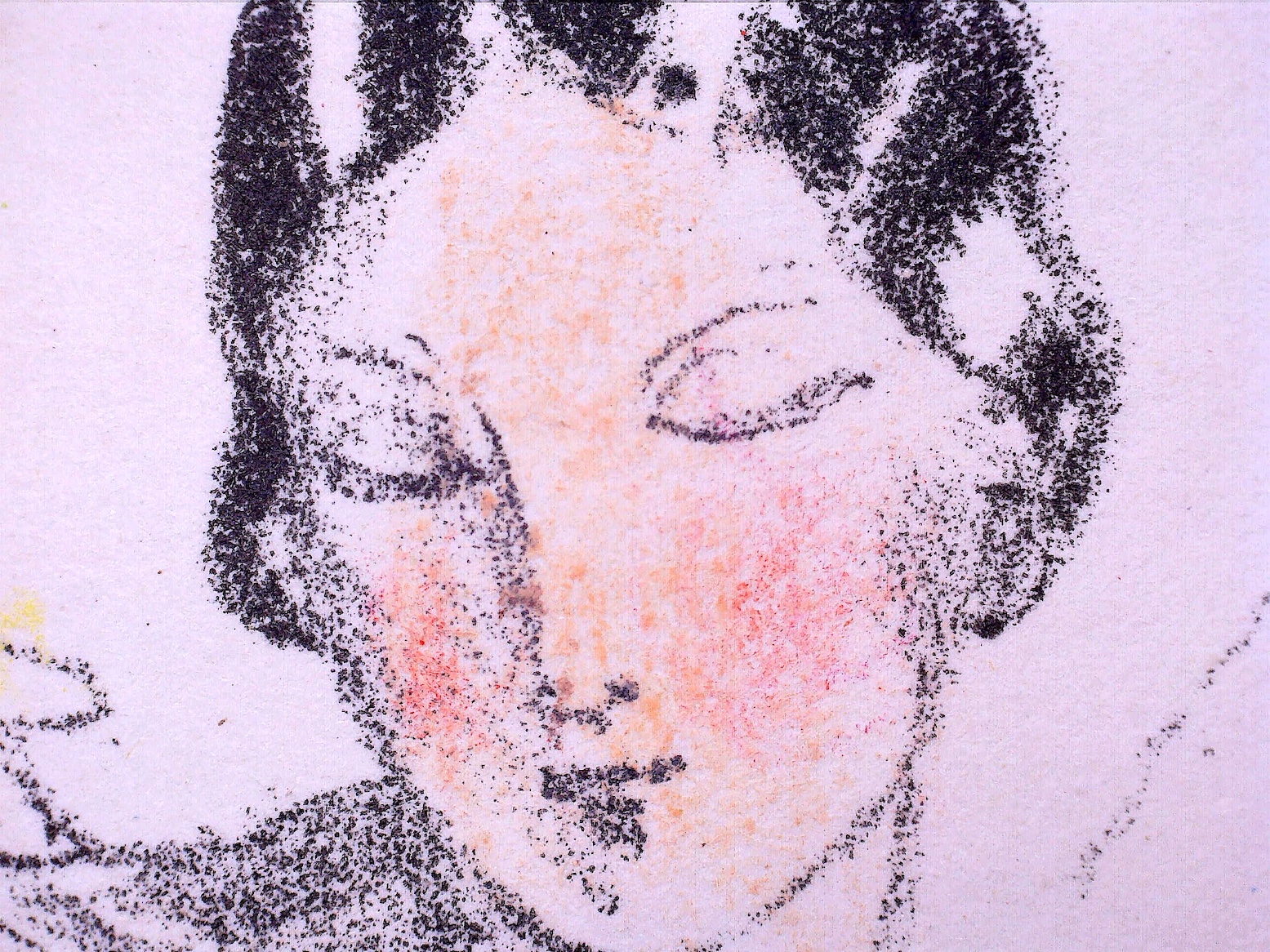
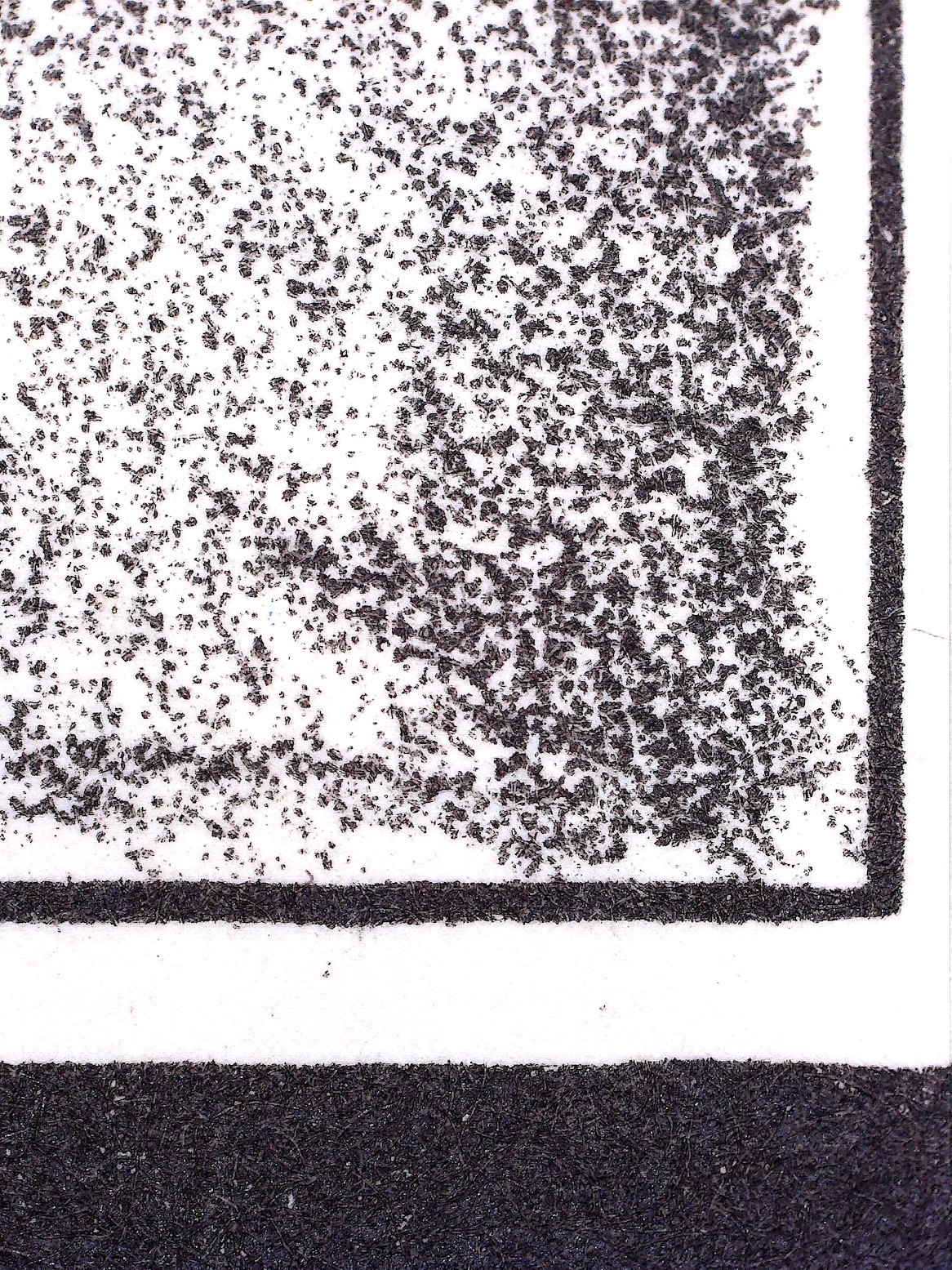
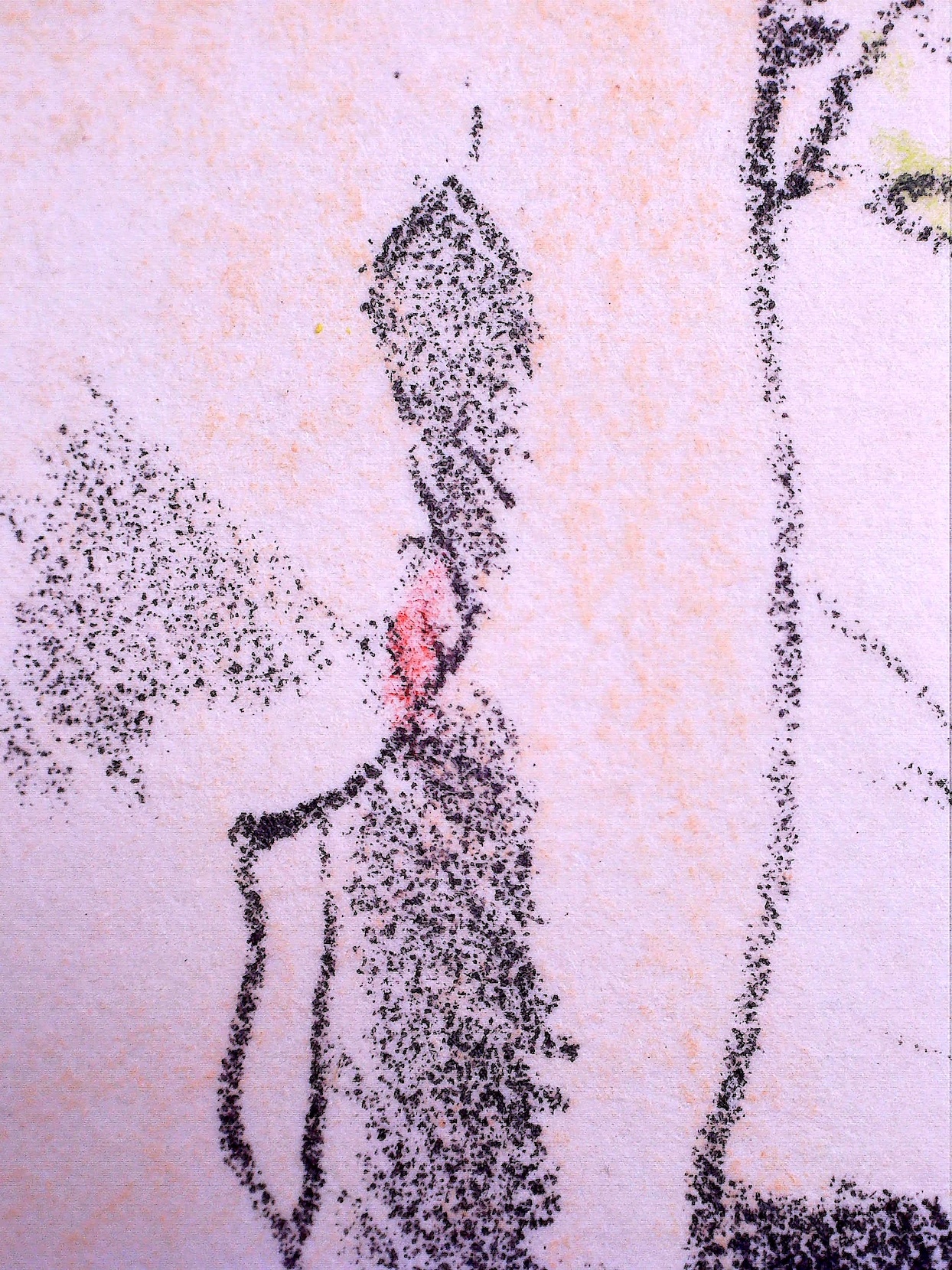
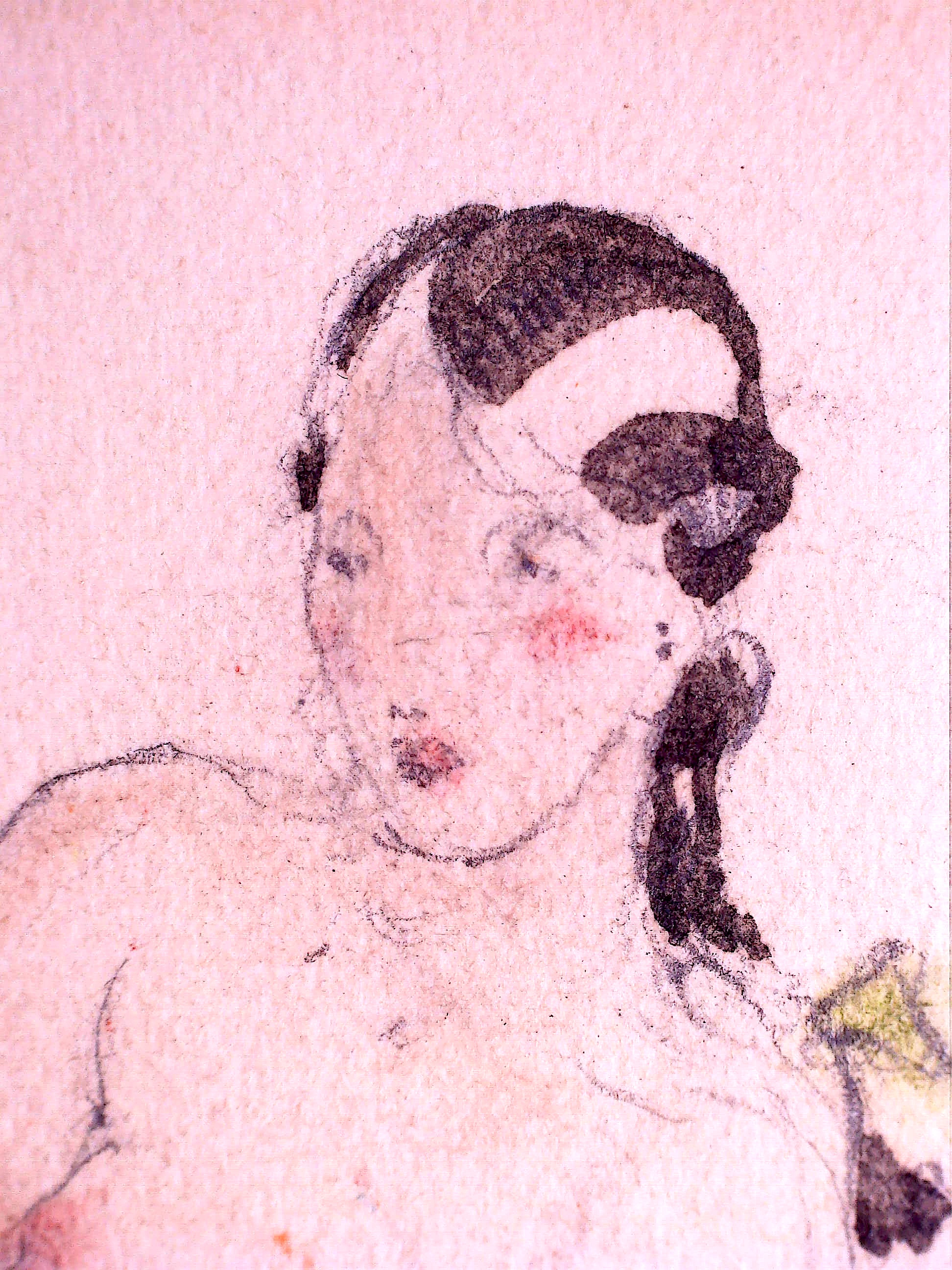
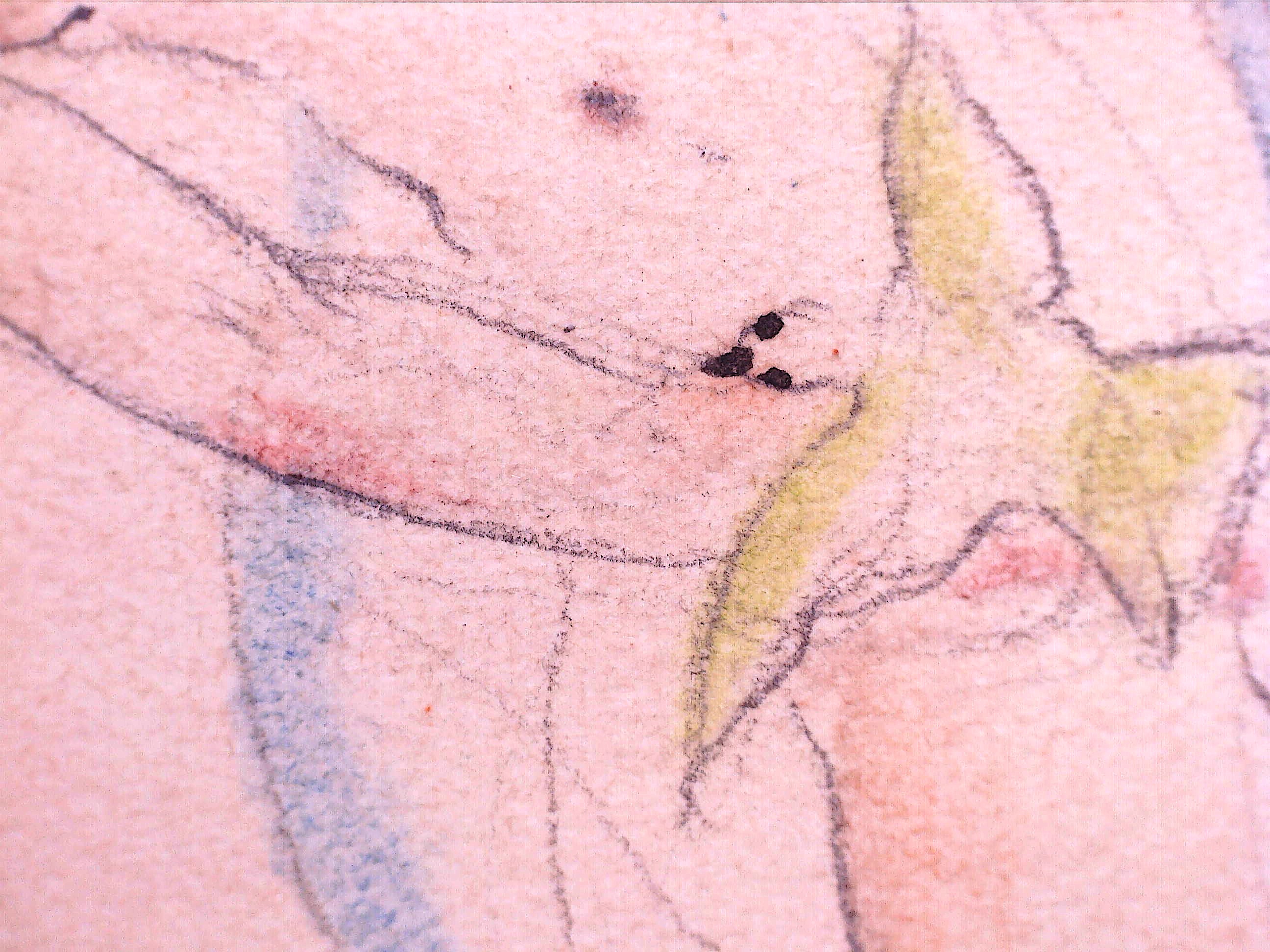
-
 A yamagane (unrefined copper) ko-kinko tsuba of slightly elongated round form with design of wisteria carved in sculptural relief (nikubori). Copper sekigane. Unsigned. Muromachi period, likely the 16th century.
A yamagane (unrefined copper) ko-kinko tsuba of slightly elongated round form with design of wisteria carved in sculptural relief (nikubori). Copper sekigane. Unsigned. Muromachi period, likely the 16th century.Size: 74.3 x 71.8 x 3.2 mm.
NBTHK certificate №4003986: Hozon (worthy preservation). In custom wooden box. -
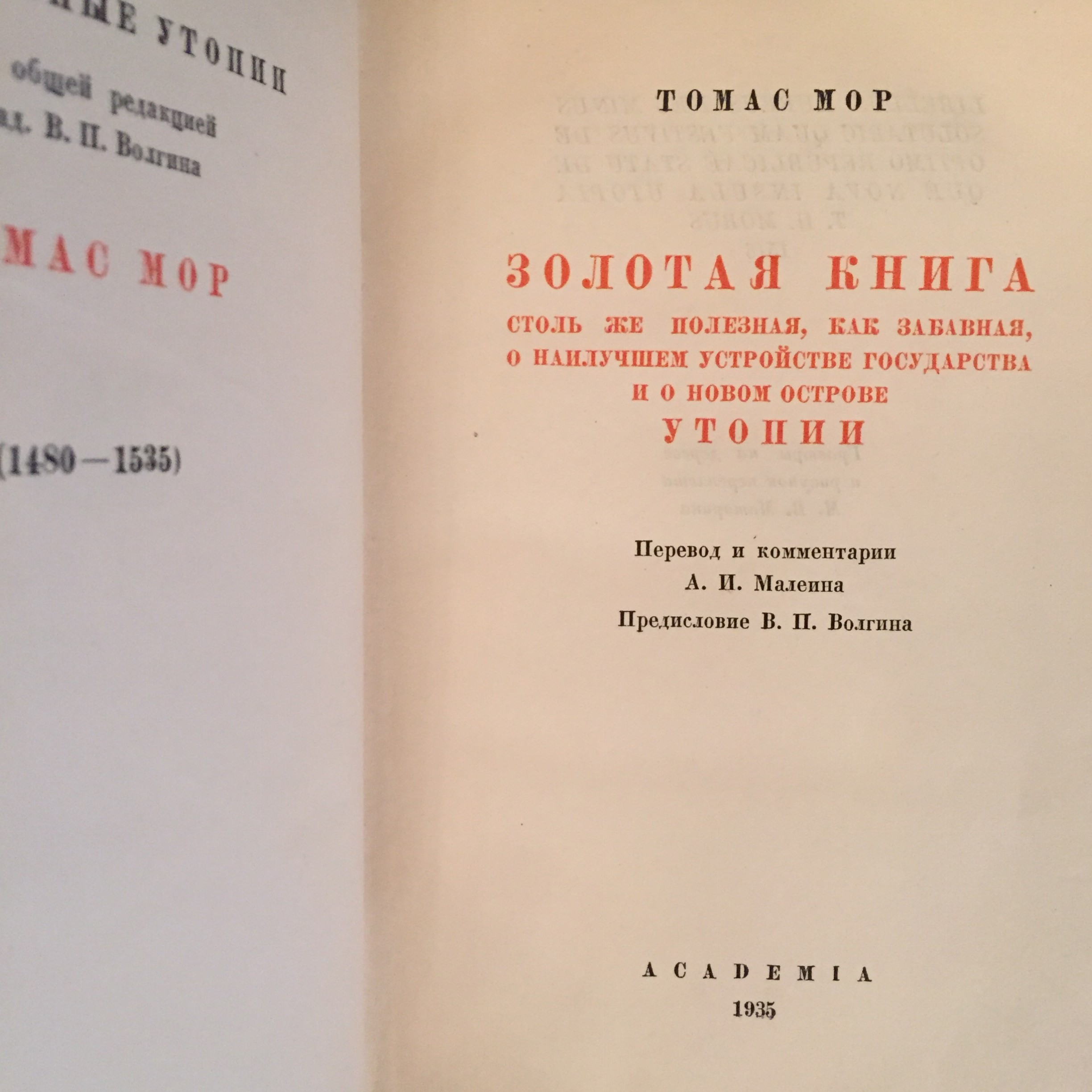
Томас Мор. Золотая книга столь же полезная, как забавная, о наилучшем устройстве государства и о новом острове Утопии. Перевод и комментарии А. И. Малеина. Предисловие В. П. Волгина. Academia, 1935. Москва - Ленинград. Гравюры на дереве и рисунок переплета М. В. Моторина.
-
 Kitagawa Utamaro (喜多川 歌麿; c. 1753 – 31 October 1806). Act III (Sandanme), from the series The Storehouse of Loyal Retainers (Chûshingura). Publisher Nishimuraya Yohachi (Eijudô). About 1801–02 (Kyôwa 1–2) Vertical ôban; 39.3 x 26 cm (15 1/2 x 10 1/4 in.). Reference: MFA ACCESSION NUMBER 11.14441 Ukiyo-e shûka 3 (1978), list #368.3; Shibui, Ukiyo-e zuten Utamaro (1964), 165.1.3; the series: Asano and Clark 1995, #s 383-5.
Kitagawa Utamaro (喜多川 歌麿; c. 1753 – 31 October 1806). Act III (Sandanme), from the series The Storehouse of Loyal Retainers (Chûshingura). Publisher Nishimuraya Yohachi (Eijudô). About 1801–02 (Kyôwa 1–2) Vertical ôban; 39.3 x 26 cm (15 1/2 x 10 1/4 in.). Reference: MFA ACCESSION NUMBER 11.14441 Ukiyo-e shûka 3 (1978), list #368.3; Shibui, Ukiyo-e zuten Utamaro (1964), 165.1.3; the series: Asano and Clark 1995, #s 383-5. -
 Iron tsuba of round form decorated with floral motif in brass or copper inlay (suemon-zōgan) and family crests (mon) in small openwork (ko-sukashi). Occasional brass dots or nail heads in brass ten-zōgan. Sukashi elements outlined with inlaid brass wire. Seppa-dai outlined with rope-shaped brass wire (nawame-zōgan); kozuka-hitsu-ana outlined with scalloped brass wire. Ōnin school. Mid to late Muromachi period, 15th or 16th century. Height: 88.9 mm; Width: 88.5 mm; Thickness at seppa-dai: 2.9 mm. Family crests (mon) in openwork: cherry blossom (sakura) - kamon of Sakurai and Yoshino clans, four-section lozenge (waribishi) - kamon of Takeda clan, the seven stars of the big dipper (maru ni nanatsuboshi) - kamon of Chiba clan, two encircled stripes (futatsubiki) - kamon of Ashikaga clan. Brass inlays represent flowers, branches and leaves, as well as halved plum blossom, halved chrysanthemum blossom, cloud, and chrysanthemum-on-water symbol - the mon of Kusunoki Masashige. Abundance of family crests of so many powerful warrior clans symbolizes heritage. "The brass trim around the kozuka hitsu-ana andd the seppa-dai are characteristics of Onin work" [Japanese sword guards. Onin - Heianjo - Yoshiro. Gary D. Murtha. GDM Publications, 2016; p. 27.]
Iron tsuba of round form decorated with floral motif in brass or copper inlay (suemon-zōgan) and family crests (mon) in small openwork (ko-sukashi). Occasional brass dots or nail heads in brass ten-zōgan. Sukashi elements outlined with inlaid brass wire. Seppa-dai outlined with rope-shaped brass wire (nawame-zōgan); kozuka-hitsu-ana outlined with scalloped brass wire. Ōnin school. Mid to late Muromachi period, 15th or 16th century. Height: 88.9 mm; Width: 88.5 mm; Thickness at seppa-dai: 2.9 mm. Family crests (mon) in openwork: cherry blossom (sakura) - kamon of Sakurai and Yoshino clans, four-section lozenge (waribishi) - kamon of Takeda clan, the seven stars of the big dipper (maru ni nanatsuboshi) - kamon of Chiba clan, two encircled stripes (futatsubiki) - kamon of Ashikaga clan. Brass inlays represent flowers, branches and leaves, as well as halved plum blossom, halved chrysanthemum blossom, cloud, and chrysanthemum-on-water symbol - the mon of Kusunoki Masashige. Abundance of family crests of so many powerful warrior clans symbolizes heritage. "The brass trim around the kozuka hitsu-ana andd the seppa-dai are characteristics of Onin work" [Japanese sword guards. Onin - Heianjo - Yoshiro. Gary D. Murtha. GDM Publications, 2016; p. 27.] -
 Shingen school (or style) tsuba of round form with an iron core of spoked-wheel shape, with its centre covered with a copper plate decorated with star-shaped punch marks. From this copper plate outward, the body is formed by brass and copper wire (flat and twisted) in a weave pattern. Both hitsu-ana are outlined in brass with a raised rim. Copper sekigane. Unsigned. Edo period, 18th century. SOLD Height: 98.0 mm, Width: 97.4 mm, Thickness at seppa-dai: 6.0 mm. Weight: 290 g. NBTHK certificate №436696: 'Hozon' attestation. Citing "JAPANESE SWORD-MOUNTS IN THE COLLECTIONS OF FIELD MUSEUM" by Helen C. Gunsaulus, Assistant Curator of Japanese Ethnology. 61 plates. Berthold Laufer, Curator of Anthropology. Field Museum of Natural History, Publication 216, Anthropological Series, Volume XVI; Chicago, 1923; p.45: "An unusual group of tsuba popular in the late sixteenth century and afterwards is made up of those guards known as Shingen tsuba, a name which was derived from a sixteenth-century warrior, Takeda Shingen (Takeda Harunobu, 1521-73), who is said to have preferred this style of guard, as it combined strength and lightness. Under the category of "Shingen", four different types abd generally listed, though a fifth appears in the drawings in the Boston Catalogue of Okabe Kakuya "Japanese Sword Guards" (p. 21). It is square, that form which is said to have been used in Ashikaga days for scaling walls, the sword having been set up as a step. [...] The following descriptions include, however, the Shingen tsuba usually met with.
Shingen school (or style) tsuba of round form with an iron core of spoked-wheel shape, with its centre covered with a copper plate decorated with star-shaped punch marks. From this copper plate outward, the body is formed by brass and copper wire (flat and twisted) in a weave pattern. Both hitsu-ana are outlined in brass with a raised rim. Copper sekigane. Unsigned. Edo period, 18th century. SOLD Height: 98.0 mm, Width: 97.4 mm, Thickness at seppa-dai: 6.0 mm. Weight: 290 g. NBTHK certificate №436696: 'Hozon' attestation. Citing "JAPANESE SWORD-MOUNTS IN THE COLLECTIONS OF FIELD MUSEUM" by Helen C. Gunsaulus, Assistant Curator of Japanese Ethnology. 61 plates. Berthold Laufer, Curator of Anthropology. Field Museum of Natural History, Publication 216, Anthropological Series, Volume XVI; Chicago, 1923; p.45: "An unusual group of tsuba popular in the late sixteenth century and afterwards is made up of those guards known as Shingen tsuba, a name which was derived from a sixteenth-century warrior, Takeda Shingen (Takeda Harunobu, 1521-73), who is said to have preferred this style of guard, as it combined strength and lightness. Under the category of "Shingen", four different types abd generally listed, though a fifth appears in the drawings in the Boston Catalogue of Okabe Kakuya "Japanese Sword Guards" (p. 21). It is square, that form which is said to have been used in Ashikaga days for scaling walls, the sword having been set up as a step. [...] The following descriptions include, however, the Shingen tsuba usually met with.- So-called Mukade ("centipede") tsuba are made of iron in which a centepede is inlaid in brass or copper wire. Mukade tsuba of Myōchin and Umetada warkmanship have been found with the inscription, "Made to the taste of Takeda Shingen".
- There are those of solid iron, with need centers of brass, to the edges of which is affixed a weaving of brass and copper wires which is bound to the foundation disk by a rim, usually decorated simply.
- Another type is of solid iron, bored at intervals and laced with braided or twisted wires of copper and brass.
- The fourth type is a chrysanthemoid form, chiselled in open work and laced or woven tightly with copper and brass wire."

Compton Collection, Part II, p.p. 26-27, №54.
-
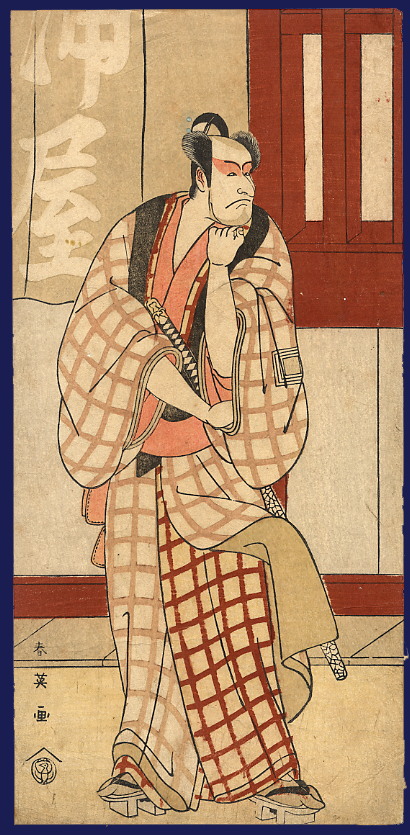 Print by Katsukawa Shun'ei that presumably depicts a kabuki actor Ichikawa Monnosuke II. I was not able to find any reference of the image. Size: Hosoban. SOLD
Print by Katsukawa Shun'ei that presumably depicts a kabuki actor Ichikawa Monnosuke II. I was not able to find any reference of the image. Size: Hosoban. SOLD


